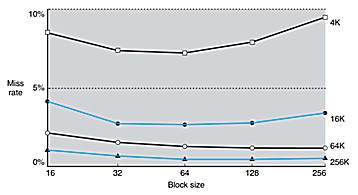| The figure shows the miss rate versus block size. Each line represents a cache of different size. Increasing the block size usually decreases the miss rate because larger blocks exploit spatial locality to lower miss rates. |

|
Note that the miss rate actually goes up if the block size is too large relative to the cache size. A more serious problem associated with just increasing the block size is that the cost of a miss increases. The steps to be taken on an instruction cache miss are
- Cache sends a miss signal to stall the processor.
- Send the original PC value (current PC – 4) to the memory.
- Instruct main memory to perform a read and wait for the memory to complete its access.
- Decide which cache block to allocate/replace.
- If the block to be replaced is modified, then move the block into a write buffer, which will be discussed later. Otherwise, the block to be replaced can be simply discarded.
- Write the cache entry by
- putting the data from memory in the data portion of the entry,
- writing the upper bits of the address (from the ALU) into the
tagfield, and - turning the valid bit on.
- Restart the instruction execution at the first step, which will refetch the instruction, this time finding it in the cache.
|
You have been out in the sun for two hours. Come on in and wet your whistle! (drink something). |